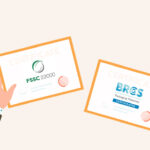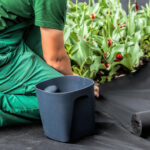Landscape fabrics are crucial in gardening and landscaping, providing effective weed control and soil protection. Choosing the right landscape fabric is essential for your garden’s long-term health and efficiency. There are two main types: woven and non-woven. Woven fabrics, made from tightly woven fibres, offer durability and strength, making them ideal for heavy-duty applications. Non-woven fabrics, made from bonded fibres, are softer and suitable for light-duty tasks. Understanding the differences between these fabrics helps you make informed decisions, ensuring your garden or landscaping project thrives. Let’s explore the unique benefits and uses of woven and non-woven landscape fabrics.
What is Woven Landscape Fabric?
Woven landscape fabric is used in gardening and landscaping to prevent weed growth and improve soil health. It is made by weaving polypropylene fibers together, creating a strong and durable fabric. This fabric allows water and nutrients to pass through, blocking growing weeds.
Materials Used
Polypropylene is the primary material used in woven landscape fabric. This type of plastic is known for its strength, durability, and resistance to moisture. These qualities make it an excellent choice for outdoor applications, ensuring the fabric lasts long and effectively protects your garden.
Properties of Woven Landscape Fabric
- Water Permeability: Woven landscape fabric allows water to pass through easily. This helps keep the soil moist and provides essential nutrients to plants.
- Weed Resistance: The tightly woven design blocks sunlight, preventing weeds from growing. This keeps your garden neat and reduces the need for chemical weed killers.
- Durability: Made from strong polypropylene fibres, woven landscape fabric is highly durable. It can withstand heavy use and resist tearing, making it ideal for long-term projects.
- UV Resistance: The fabric is treated to resist UV rays from the sun. This prevents it from breaking down over time, ensuring it remains effective for years.
- Soil Compatibility: Woven landscape fabric is compatible with various soil types. It maintains soil structure while preventing erosion, making it a versatile choice for gardening and landscaping needs.
Applications
- Gardens: Woven landscape fabric is commonly used to prevent weed growth and retain soil moisture. It helps create a clean, well-maintained garden bed and reduces the need for frequent weeding.
- Landscaping: In landscaping, woven fabric is used under mulch, gravel, and stone pathways. It provides a stable base, prevents weed growth, and enhances the appearance of landscaped areas.
- Agriculture: Farmers use woven landscape fabric to protect crops from weeds and conserve soil moisture. It promotes healthier plant growth and increases crop yields by reducing nutrient competition.
Installation Process
Follow this detailed guide for landscape fabric installation:
- Measure and Cut: Measure the area and cut the woven landscape fabric to fit. Leave extra fabric around the edges for adjustments.
- Lay the Fabric: Place the fabric on the prepared ground, ensuring it lies flat and covers the entire area.
- Secure the Edges: Use landscape fabric staples or pins to secure the edges of the fabric. Place them about 12 inches apart to keep the fabric in place.
- Overlap the Seams: If using multiple pieces of fabric, overlap the seams by 6 inches to prevent weeds from growing through gaps.
- Cover the Fabric: Add a layer of mulch, gravel, or soil on top of the fabric to protect it and improve the appearance of your garden or landscape.
What is Non-Woven Landscape Fabric?
Non-woven landscape fabric is used in gardening and landscaping to control weeds and retain soil moisture. Unlike woven fabric, it is made by bonding fibers using heat or chemicals, creating a felt-like texture. This fabric is softer and more flexible, making it easy to cut and shape for various applications.
Non-woven landscape fabric is typically made from durable and water-resistant polypropylene. This material ensures the fabric can withstand outdoor conditions while blocking weeds and allowing water to pass through.
Comparison: Woven vs Non-Woven Landscape Fabric
Durability
Woven landscape fabric is more durable than non-woven fabric. Its tightly woven fibers make it resistant to tearing and damage, ideal for long-term use. Non-woven fabric, while durable, is less robust and better suited for temporary or light-duty applications.
Permeability
Both woven and non-woven fabrics allow water and nutrients to pass through. However, woven fabric typically offers better permeability, ensuring that plants receive ample water and nutrients. Non-woven fabric is slightly less absorbent but still effective in maintaining soil moisture.
Cost
Woven landscape fabric is generally more expensive than non-woven fabric due to its higher durability and strength. Non-woven fabric is a more budget-friendly, making it a good choice for short-term projects or areas with less demanding conditions.
Best Use Cases
- Woven Fabric: Best for long-term projects, heavy-duty applications, high-traffic areas, and places requiring extra durability.
- Non-Woven Fabric: Ideal for light-duty applications, temporary projects, and budget-conscious gardening or landscaping tasks.
Why Choose Woven Landscape Fabric?
Long-term Investment
Choosing woven landscape fabric is a smart long-term investment. Its high durability means it lasts for years, reducing the need for frequent replacements. This saves you time and money in the long run. The strong material resists tearing and wear, ensuring your garden or landscaping project remains protected and looks good over time.
Versatility
Woven landscape fabric is highly versatile and suitable for various applications. Use it in gardens to control weeds and retain soil moisture, in landscaping to create tidy, weed-free areas, and in construction to stabilize soil and prevent erosion. Its strength and durability make it suitable for both heavy-duty and light-duty tasks.
Woven landscape fabric is a reliable, long-lasting solution for gardening and landscaping needs. Its durability, strength, and superior permeability make it an excellent choice for various applications, from gardens to construction projects. While it may cost more upfront, its long-term benefits and versatility offer significant value for money. By choosing woven landscape fabric, you invest in a product that ensures your outdoor spaces remain well-maintained and attractive for years. Make the smart choice and enjoy the lasting benefits of woven landscape fabric.




